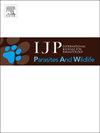Molecular identification of Trichuris species in long-tailed macaques from Dong Ling Don Chao Pu Park and Kumphawapi Monkey Garden, Northeast Thailand: First report suggesting possible Trichuris ovis infection in non-human primates
IF 2
3区 医学
Q3 ECOLOGY
International Journal for Parasitology-Parasites and Wildlife
Pub Date : 2025-04-01
DOI:10.1016/j.ijppaw.2025.101063
引用次数: 0
Abstract
This study aimed to molecularly identify Trichuris spp. in long-tailed macaques from two key habitats in Northeast Thailand: Dong Ling Don Chao Pu Park, Amnat Charoen Province, and Kumphawapi Monkey Garden, Udon Thani Province. Genomic DNA was extracted from 13 Trichuris spp. egg samples collected from 13 infected long-tailed macaques, and PCR amplification targeting partial sequences of the 18S rRNA gene and ITS2 region was performed for phylogenetic analysis. Of the 13 Trichuris spp. egg samples, the partial 18S rRNA gene was successfully amplified from six, while ITS2 amplification was unsuccessful. Phylogenetic analysis indicated that four specimens sequenced from Dong Ling Don Chao Pu Park were T. trichiura. In contrast, two specimens sequenced from Kumphawapi Monkey Garden clustered with the only confirmed T. ovis from goat, as well as unconfirmed Trichuris spp. from other ruminant hosts. These findings suggest that the Trichuris spp. in macaques are likely T. ovis; however, the evidence remains inconclusive. Therefore, accurate species identification in this region requires further molecular analysis using additional genetic markers. This study provides the first molecular identification of T. trichiura in long-tailed macaques from Northeast Thailand. Additionally, it is the first report suggesting the possible T. ovis infection in non-human primates. These findings highlight the potential for Trichuris spp. transmission across diverse host species, underscoring the need for enhanced surveillance of parasitic infections in wildlife and livestock, particularly in regions with close human-animal interactions. Continued molecular investigations are essential to elucidate Trichuris spp. transmission dynamics and zoonotic potential, aiding in public health risk mitigation.

泰国东北东陵东朝浦公园和Kumphawapi猴园长尾猕猴中毛滴虫的分子鉴定:首次提示非人类灵长类动物中可能存在毛滴虫感染
本研究旨在对泰国东北部两个主要栖息地——Amnat Charoen省Dong Ling Don Chao Pu公园和Udon Thani省Kumphawapi Monkey Garden的长尾猕猴进行Trichuris spp.的分子鉴定。从13只感染长尾猕猴的13只毛猴卵中提取基因组DNA,对18S rRNA基因和ITS2区域的部分序列进行PCR扩增,进行系统发育分析。在13份毛滴虫卵中,6份成功扩增到部分18S rRNA基因,而ITS2基因扩增失败。系统发育分析表明,从东陵东朝铺公园获得的4份标本均为毛毛蝗。相比之下,来自Kumphawapi猴园的两个标本与来自山羊的唯一确认的鹅绦虫以及来自其他反刍动物宿主的未经确认的毛线虫属聚集在一起。这些发现表明猕猴体内的毛滴虫很可能是T. ovis;然而,证据仍然没有定论。因此,准确的物种鉴定需要使用额外的遗传标记进行进一步的分子分析。本研究首次在泰国东北部的长尾猕猴中鉴定出毛螺旋体。此外,这是首次提出在非人类灵长类动物中可能存在卵巢绦虫感染的报告。这些发现突出了毛滴虫在不同宿主物种间传播的可能性,强调了加强对野生动物和牲畜中寄生虫感染监测的必要性,特别是在人与动物密切互动的地区。继续进行分子调查对于阐明毛滴虫的传播动力学和人畜共患的可能性至关重要,有助于减轻公共卫生风险。
本文章由计算机程序翻译,如有差异,请以英文原文为准。
求助全文
约1分钟内获得全文
求助全文
来源期刊

International Journal for Parasitology-Parasites and Wildlife
Medicine-Infectious Diseases
CiteScore
3.80
自引率
5.60%
发文量
113
审稿时长
45 days
期刊介绍:
The International Journal for Parasitology: Parasites and Wildlife (IJP-PAW) publishes the results of original research on parasites of all wildlife, invertebrate and vertebrate. This includes free-ranging, wild populations, as well as captive wildlife, semi-domesticated species (e.g. reindeer) and farmed populations of recently domesticated or wild-captured species (e.g. cultured fishes). Articles on all aspects of wildlife parasitology are welcomed including taxonomy, biodiversity and distribution, ecology and epidemiology, population biology and host-parasite relationships. The impact of parasites on the health and conservation of wildlife is seen as an important area covered by the journal especially the potential role of environmental factors, for example climate. Also important to the journal is ''one health'' and the nature of interactions between wildlife, people and domestic animals, including disease emergence and zoonoses.
 求助内容:
求助内容: 应助结果提醒方式:
应助结果提醒方式:


